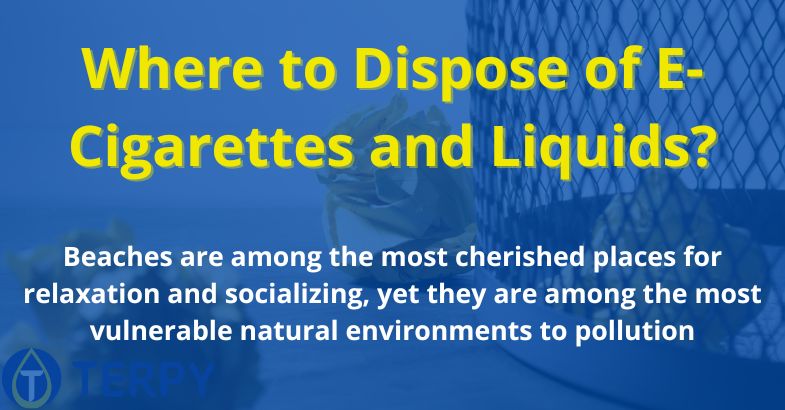Published on: 28/03/2025
A Complete Guide to Proper Disposal of Electronic Waste and E-Cigarette Liquids
Like any technological device, disposing of e-cigarette waste presents a challenge. With the increasing use of e-cigs, it is essential to know how to dispose of them correctly to prevent environmental damage and comply with regulations.
In this article, we will explore where and how to dispose of e-cigarettes, batteries, and liquids, providing a comprehensive guide for those who want to adopt responsible and sustainable practices.
The Importance of Properly Disposing of E-Cigarettes
In recent years, e-cigarettes have become increasingly popular, with millions of users worldwide using them daily. However, if not disposed of correctly, they can significantly contribute to environmental pollution. E-cigarettes contain various components, including lithium batteries, electronic circuits, and liquid cartridges, each requiring specific disposal methods to prevent environmental damage.
Where Should You Dispose of Your E-Cigarette?
E-cigarettes, like other electronic devices, should not be thrown into regular household waste bins. This is to prevent the chemicals and non-biodegradable materials they contain from contaminating the soil, water, and air.
When disposing of e-cigarettes, it is crucial to consider local laws and regulations regarding electronic waste. Since e-cigarettes contain electronic components, such as batteries, they fall under the category of electronic waste and must be handled separately.
In many countries, e-cigarettes should be disposed of as electronic waste at designated collection centers. This is particularly important for devices containing lithium batteries, which can be hazardous if not properly managed. Lithium batteries not only pose a risk of environmental contamination but, if damaged, can also cause fires or explosions.
The best solution is to take your e-cigarette to an electronic waste collection center. These facilities are equipped to safely process electronic devices and recover valuable materials, such as lithium, which can be reused.
Read also : Cigarette Butt Pollution on Beaches


What to Do with Your E-Cigarette Battery?
The battery in e-cigarettes is one of the most critical components when it comes to disposal. Lithium batteries are commonly used in modern electronic devices, and if not disposed of properly, they can pose a serious risk to the environment and human health.
Although an e-cigarette may seem like a small device, the battery inside it must be treated as hazardous waste. Many cities and municipalities provide designated collection points for batteries, where they can be safely disposed of. If you’re unsure where to find these collection points, check your local government’s website or visit specialized stores, such as electronics retailers, which often offer battery recycling services.
And What About E-Cigarette Liquids?
Another crucial aspect of e-cigarette waste management is the proper disposal of liquids. Many users tend to throw empty cartridges or vials into regular trash bins, but this is a mistake. E-cigarette liquids often contain nicotine, propylene glycol, vegetable glycerin, and flavorings, all of which require careful disposal.
If the liquid container is empty, the best way to dispose of it is by placing it in a designated liquid waste bin if available in your area. Some hazardous waste collection centers accept e-cigarette liquids, while others may have specific guidelines for their disposal.
If there is still liquid inside the tank or cartridge, it is crucial not to pour it down the sink or toilet. Wastewater treatment systems are not designed to handle the chemicals found in e-cig liquids, which could lead to contamination of groundwater and water bodies.
Adhere to Local Regulations
Each country has different regulations regarding the disposal of electronic waste and e-cigarette liquids. Therefore, it is essential to stay informed about the specific laws and guidelines in your city or country. In some places, e-waste and e-liquids are classified as hazardous waste, requiring participation in specialized collection programs or disposal at designated recycling facilities.
Another important consideration is the growing concern over the environmental impact of disposable e-cigarettes. Many experts argue that single-use devices, which are discarded after just one use, significantly contribute to pollution. Adopting more sustainable alternatives, such as refillable devices and reusable liquids, is one of the key solutions to reducing the environmental footprint of e-cigarettes.
Read also : Where Can You Vape Your E-Cigarette?


How to Prevent E-Cigarette Waste?
The best way to reduce the environmental impact of e-cigarettes is to prevent waste production in the first place. This means opting for rechargeable devices and minimizing the purchase of disposable e-cigarettes. Additionally, choosing e-liquids in larger containers can help reduce the amount of plastic and packaging waste.
Many e-cigarette manufacturers are already making progress in designing more sustainable and reusable devices, reducing the need for frequent disposal of plastic and electronic components. Selecting e-liquids free from harmful ingredients can also help lower the risks associated with improper disposal.
Conclusions
E-cigarettes, while a viable alternative to traditional smoking, require proper waste management to prevent environmental harm. It is essential to dispose of lithium batteries, electronic devices, and e-cigarette liquids correctly, following local regulations and adopting sustainable practices. Only through responsible behavior can we reduce the environmental impact of these devices and contribute to a more eco-friendly approach to electronic waste management.
For those seeking a more sustainable future, awareness of the importance of recycling and proper disposal of e-cigarettes and liquids is crucial. Finding solutions that minimize ecological damage is a key step toward protecting our planet.





